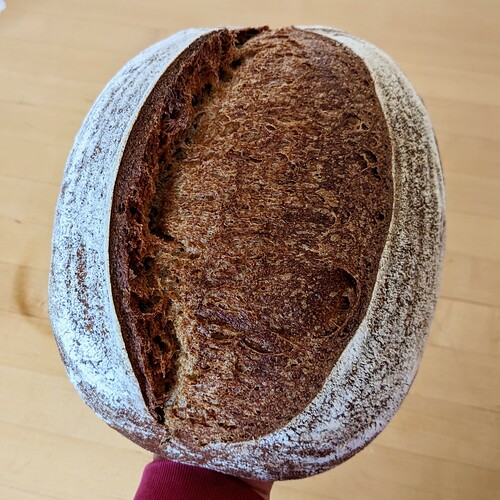Hi Misha, those are good questions.
I’m afraid I probably don’t have good answers, but I’ll give it my best shot.
I can’t speak for Chad Robertson or Debra Wing or any of the rest of the majority of people who do prefer to use a well-fed starter in the vicinity of its peak. That way of making sourdough bread totally works. For my part, if I want really not-sour bread, I’ll make up a one-time levain and feed it once or twice to make it very active and use a lot (by comparison with my usual practice) of it so the dough rises very fast. I will also not retard that dough, so the whole loaf is a few hours from mixing to baking and it all happens at room temperature (until the oven).
I think this is a bit of an over-simplification. There are so many things going on in a fermenting dough. Along with a lot of other things that affect the ultimate loaf, the acid buildup is both affecting microbes (both yeast and bacteria) reproduction and metabolism directly, and it also has a deleterious effect on gluten formation.
Without doing a lot of empirical measurements and observations that I’ve never done, I can’t say anything meaningful about what is happening over time in the method I use, but I have a theory that basically goes like this:
I am using a tiny amount of starter in a relatively huge amount of dough. At the inoculation percentage that I am talking about, the acidity level of my starter is meaningless, as is the relative population of different microbes in the starter. Because the giant playground of food they just got mixed into so dwarfs the microbial environment of the starter, it’s like a giant reset button and they start going nuts in a clear, unconstrained field filled with food at a neutral pH. That’s how I think of it anyway.
So then over the hours they are spreading rapidly through the dough it’s a long time before their activity starts to affect the dough’s properties - mainly acidity level. Basically we just created a brand new, giant levain. And for me, the bulk fermentation period is letting that large levain ripen.
Because I use such a small amount of starter the initial part of that bulk proof is a lot longer than in more conventional sourdough bread recipes. I think that’s because it takes a while for the microbes to physically saturate the whole dough and get to the point where their competition for food and their waste products are starting to actually reshape their environment (i.e. change the dough’s properties). But once you get to a certain point of microbial spread, from that point onward the timing from the baker’s point of view is more or less the same as with a more conventional recipe / method.
I don’t know this is true for sure, but I hypothesize that the length of the bulk fermentation (and then the long, cold final proof) is responsible for developing flavor that I really like. My bread is not super sour at all. You can taste a little acidity but it’s really not like what people think of as a “San Francisco” sourdough bread. It does have a really rich and complex flavor that I like a lot.
Over time, I’ve found that for my preferences, using the whole grains that I like, once the dough’s volume is at ~150% - ~200% of where it started when I mixed it up, it’s ripe enough for shaping and then a long retarded final proof in the fridge over night.
Then I bake it up the next morning and I get something like this recent loaf:
…which I’m happy with.

